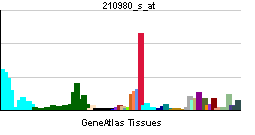ASAH1
| N-acylsphingosine amidohydrolase (acid ceramidase) 1 | |||||||||||
|---|---|---|---|---|---|---|---|---|---|---|---|
| Identifiers | |||||||||||
| Symbols | ASAH1 ; AC; ASAH; FLJ21558; FLJ22079; PHP; PHP32 | ||||||||||
| External IDs | Template:OMIM5 Template:MGI HomoloGene: 10504 | ||||||||||
| |||||||||||
| RNA expression pattern | |||||||||||
 | |||||||||||
 | |||||||||||
| More reference expression data | |||||||||||
| Orthologs | |||||||||||
| Template:GNF Ortholog box | |||||||||||
| Species | Human | Mouse | |||||||||
| Entrez | n/a | n/a | |||||||||
| Ensembl | n/a | n/a | |||||||||
| UniProt | n/a | n/a | |||||||||
| RefSeq (mRNA) | n/a | n/a | |||||||||
| RefSeq (protein) | n/a | n/a | |||||||||
| Location (UCSC) | n/a | n/a | |||||||||
| PubMed search | n/a | n/a | |||||||||
N-acylsphingosine amidohydrolase (acid ceramidase) 1, also known as ASAH1, is a human gene.[1]
This gene encodes a heterodimeric protein consisting of a nonglycosylated alpha subunit and a glycosylated beta subunit that is cleaved to the mature enzyme posttranslationally. The encoded protein catalyzes the synthesis and degradation of ceramide into sphingosine and fatty acid. Mutations in this gene have been associated with a lysosomal storage disorder known as Farber disease. Two transcript variants encoding distinct isoforms have been identified for this gene.[1]
References
Further reading
- Perry DK, Hannun YA (1999). "The role of ceramide in cell signaling". Biochim. Biophys. Acta. 1436 (1–2): 233–43. PMID 9838138.
- Bernardo K, Hurwitz R, Zenk T; et al. (1995). "Purification, characterization, and biosynthesis of human acid ceramidase". J. Biol. Chem. 270 (19): 11098–102. PMID 7744740.
- Maruyama K, Sugano S (1994). "Oligo-capping: a simple method to replace the cap structure of eukaryotic mRNAs with oligoribonucleotides". Gene. 138 (1–2): 171–4. PMID 8125298.
- Koch J, Gärtner S, Li CM; et al. (1997). "Molecular cloning and characterization of a full-length complementary DNA encoding human acid ceramidase. Identification Of the first molecular lesion causing Farber disease". J. Biol. Chem. 271 (51): 33110–5. PMID 8955159.
- Suzuki Y, Yoshitomo-Nakagawa K, Maruyama K; et al. (1997). "Construction and characterization of a full length-enriched and a 5'-end-enriched cDNA library". Gene. 200 (1–2): 149–56. PMID 9373149.
- Li CM, Park JH, He X; et al. (2000). "The human acid ceramidase gene (ASAH): structure, chromosomal location, mutation analysis, and expression". Genomics. 62 (2): 223–31. doi:10.1006/geno.1999.5940. PMID 10610716.
- Seelan RS, Qian C, Yokomizo A; et al. (2000). "Human acid ceramidase is overexpressed but not mutated in prostate cancer". Genes Chromosomes Cancer. 29 (2): 137–46. PMID 10959093.
- Strelow A, Bernardo K, Adam-Klages S; et al. (2000). "Overexpression of acid ceramidase protects from tumor necrosis factor-induced cell death". J. Exp. Med. 192 (5): 601–12. PMID 10974027.
- Bär J, Linke T, Ferlinz K; et al. (2001). "Molecular analysis of acid ceramidase deficiency in patients with Farber disease". Hum. Mutat. 17 (3): 199–209. doi:10.1002/humu.5. PMID 11241842.
- Ferlinz K, Kopal G, Bernardo K; et al. (2001). "Human acid ceramidase: processing, glycosylation, and lysosomal targeting". J. Biol. Chem. 276 (38): 35352–60. doi:10.1074/jbc.M103066200. PMID 11451951.
- Strausberg RL, Feingold EA, Grouse LH; et al. (2003). "Generation and initial analysis of more than 15,000 full-length human and mouse cDNA sequences". Proc. Natl. Acad. Sci. U.S.A. 99 (26): 16899–903. doi:10.1073/pnas.242603899. PMID 12477932.
- Muramatsu T, Sakai N, Yanagihara I; et al. (2003). "Mutation analysis of the acid ceramidase gene in Japanese patients with Farber disease". J. Inherit. Metab. Dis. 25 (7): 585–92. PMID 12638942.
- Zhang H, Li XJ, Martin DB, Aebersold R (2003). "Identification and quantification of N-linked glycoproteins using hydrazide chemistry, stable isotope labeling and mass spectrometry". Nat. Biotechnol. 21 (6): 660–6. doi:10.1038/nbt827. PMID 12754519.
- Okino N, He X, Gatt S; et al. (2003). "The reverse activity of human acid ceramidase". J. Biol. Chem. 278 (32): 29948–53. doi:10.1074/jbc.M303310200. PMID 12764132.
- He X, Okino N, Dhami R; et al. (2003). "Purification and characterization of recombinant, human acid ceramidase. Catalytic reactions and interactions with acid sphingomyelinase". J. Biol. Chem. 278 (35): 32978–86. doi:10.1074/jbc.M301936200. PMID 12815059.
- Ota T, Suzuki Y, Nishikawa T; et al. (2004). "Complete sequencing and characterization of 21,243 full-length human cDNAs". Nat. Genet. 36 (1): 40–5. doi:10.1038/ng1285. PMID 14702039.
- Hara S, Nakashima S, Kiyono T; et al. (2005). "p53-Independent ceramide formation in human glioma cells during gamma-radiation-induced apoptosis". Cell Death Differ. 11 (8): 853–61. doi:10.1038/sj.cdd.4401428. PMID 15088070.
- Gerhard DS, Wagner L, Feingold EA; et al. (2004). "The status, quality, and expansion of the NIH full-length cDNA project: the Mammalian Gene Collection (MGC)". Genome Res. 14 (10B): 2121–7. doi:10.1101/gr.2596504. PMID 15489334.
- Lewandrowski U, Moebius J, Walter U, Sickmann A (2006). "Elucidation of N-glycosylation sites on human platelet proteins: a glycoproteomic approach". Mol. Cell Proteomics. 5 (2): 226–33. doi:10.1074/mcp.M500324-MCP200. PMID 16263699.
| This protein-related article is a stub. You can help Wikipedia by expanding it. |